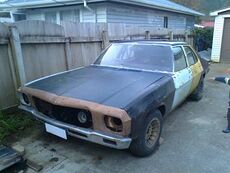Seat belt
“I like researching seat belts, they're fastenating.”
A seat belt, sometimes called a safety belt, is a widely misunderstood "safety" device commonly used in the automotive industry to attach humans, pets or objects inescapably to a car seat, similar in principle to a tie-down strap used to secure trailer loads, but with a much more irritating ratchet system. It is primarily used by middle-class white people to build a false sense of security and by all obese people to reduce the hazard of belly jiggle.
Invention and History[edit]
Seat belts were invented in Australia in 1954 to prevent children from escaping from cars, as they predate the invention of the child safety lock, shock collar and superglue by a number of years. First introduced by car-maker Holden in the HQ 1956 model, it was accompanied by a series of early television advertisements featuring lower working-class/unemployed women driving to the local pub in the late morning, "belting" their kids into the car, then returning intoxicated to the vehicle in the evening to find them still present. These advertisements — and the seat belt in general — received extensive praise from safety organisations and child-welfare activists at the time for reducing the large number of lower-class children going missing and eventually being adopted by dingos or Brangelina.
Unfortunately, the purpose of the seat belt was widely misunderstood by middle-class whitey. This has been attributed to two main factors:
- Over-design. Particularly perplexing to middle-class whitey was the extremely thick and strong nature of the seat belts their new car came equipped with, which generally led to the belief that it was for adult use. Unbeknownst to them, the original design specification had required the belt to be strong enough to withstand the worst-case "Dole Day" scenario. This scenario required that the belt withstand a wriggly, mullet-bearing white-trash child for up to 14 hours at a time on Dole Day (9am bank opening time to 11pm pub closing time).
- Neglect. Middle-class whitey, despite their many, many, many faults as human beings, are known to be very good and attentive to their children so that they will grow up to doctors, lawyers, Uncyclopedia contributors, confidence fraudsters and chronic stoners. The concept of affixing their child to a car seat so they could go and get shit-faced was an entirely alien concept. After all, that's what babysitters are for.
This widespread misunderstanding led to serious safety issues and is the second largest cause of death in human history, as distant second to wardrobe malfunction.
Safety Concerns[edit]
The seat belt is the single most dangerous item of automotive equipment since the invention of the Infernal Contraption by Henry Fourdoor in 1908. In its intended application it was not only harmless but saved lives; however, in its current misinterpreted use it has been the second highest killer of people in general in human history (after wardrobe malfunction) and fourth highest killer of middle-class white people (after wardrobe malfunction, chronic alcoholism and schnauzer overdose). It has been proven to be entirely safe for white trash, natives, gypsies and miniature schnauzers, though studies have been inconclusive as to the cause of this.
The main safety risk is that the belt prevents the occupant's escape during a crash, panic attack, wicked drift, or out-of-control hot-box session, virtually guaranteeing their death. The fundamental design of the automotive conveyance from its very inception — forward-facing seats, thin glass shield at the front, and sloped bonnet — is intended specifically to eject the occupants in the event of a sudden crash or attack of violent flatulence, thus clearing them of the inevitable carnage and/or fire/explosion taking place within the cabin. By ejecting them through the windscreen to safety, the occupants may then flee the scene of the crash (particularly if inebriated or having been driving while asleep) and seek medical attention if required.
If inappropriately restrained by a belt, the occupant is in danger of:
- a) Roasting like a marshmallow.
- b) Becoming trapped within the vehicle.
- c) Becoming bored after being trapped within the vehicle.
- d) Becoming depressed from being bored after being trapped within the vehicle.
- e) Embracing Islam and engaging in suicide bombing after becoming depressed from being bored after being trapped within the vehicle.
- f) Being convicted of driving under whatever form of intoxication caused the crash in the first place.
- g) Shingles
Unfortunately, initiatives to educate the public on the dangers of seat belts have also been largely misunderstood. The "Don't Strap It On" media campaign in the early 2000s in particular was interpreted as a defamation attempt against lesbians, resulting in the notorious Female Body Builder Strike of 2003.
Scientific studies conclusively demonstrating the danger of seat belts have also been ignored or ridiculed by governments throughout the world. This is embodied by the statement by Newt Gingrich, "There is no seat belt danger." Sadly, the danger continues to be ignored, and, by 2050, is expected to lead to catastrophic rises in global embarrassment by conservatives.


